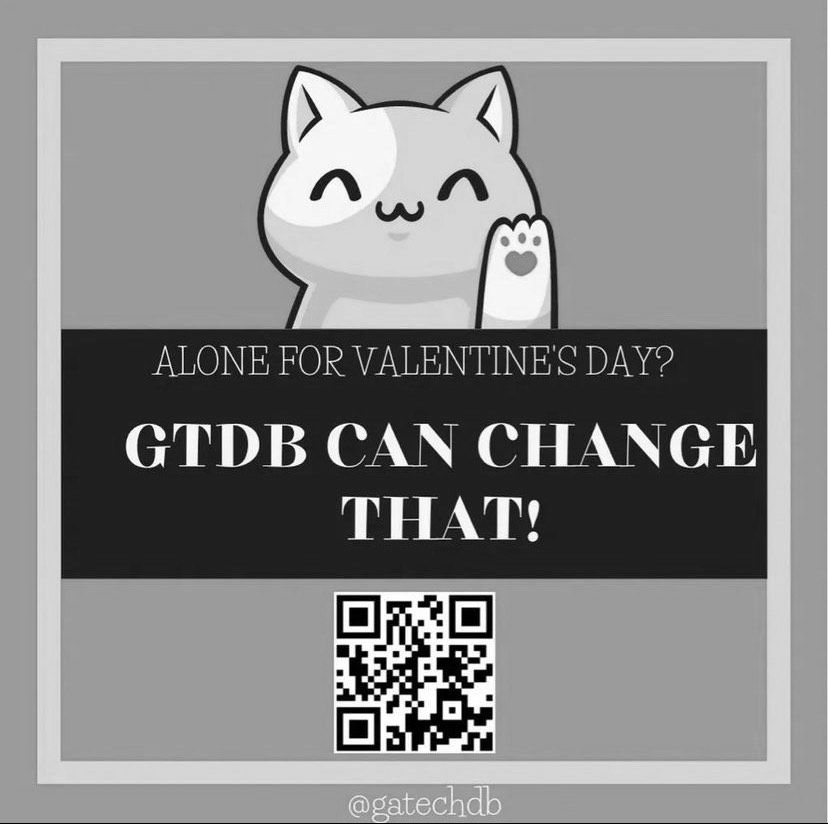Georgia Tech Dating Blind (GTDB) is the newest non-institute affiliated social media account making buzz on campus with its Valentine’s survey.
Aimed at helping Tech students find love, GTDB says they plan to use survey responses to match Tech students up with their perfect date using their algorithm.
With advertising posters finding their way all across Tech’s campus and an active social media presence, the account has gained wide notoriety with students of all backgrounds on campus, already garnering over 1,000 responses as of Feb. 8.
Throughout the years, Tech has seen its fair share of dating services make their way through campus, each one with its own claim to fame.
To learn more about the goals of GTDB and the Valentine’s Survey, the Technique has reached out to GTDB president, Harsha Gaddipati, first-year CS and Julie Young, first-year CS to ask them about the organization and their hopes for its future.
Gaddipati explained that they gained inspiration from the “Stanford Marriage Act” questionnaire, which was a similar service that matched up students with peers on Stanford’s campus for dates.
The initial team, which has now grown to 22 people, consisted of just a few friends.
“We started thinking about it around November. And then it kind of evolved from there to be a little bit different … more on the serious side, I’d say comparatively to marriage pact.” Gaddipati said.
From conception to present, the entire process has only taken about three months with the first six weeks being dedicated to question development, a turning point in the project.
“There was a lot of arguing over what questions [we would include]. I was leaning towards more lighthearted questions that I thought were funny, but maybe not necessarily the most revealing [in terms of] people’s character.” Gaddipati said.
He continued, explaining the value different perspectives brought the team.
“Julie was more on the side of more focused questions that actually gave some more personality and more depth. And so then after that, we started developing the back algorithms.” Gaddipati said.
From here, the team tested their survey on a group of 40 people to check for potential biases, measure effectiveness and identify initial issues.
The pair also expressed a desire to grow their platform and use their algorithm in a wider range of situations, such as assisting first-year students find roommates or friends.
Young explained that for this current project, in addition to being notified of their match, students will also receive a recommended date location based on their responses to the survey.
“Part of the reason for that is we also want to encourage people to actually go meet their match, since they have to reach out themselves” she said.
Students may wonder about the thought process behind choosing and implementing the algorithm that processes the survey results. Gaddipati revealed that the Nobel Memorial award winning Gale-Shapley algorithm appealed to them the most.
He went on to explain that the Gale-Shapley algorithm is based on the theory that people with similarities tend to attract one another. From here, the team modified the algorithm to ensure no one is left without a match.
GTBD also shared some general statistics from the survey responses, sharing data aggregates on demographics as per their privacy policy.
As of Sunday, Feb. 7, the male-female respondent ratio shows that majority males have responded to the survey so far, in addition to a few individuals who identify as nonbinary.
To assure everyone gets at least one match, some people were matched to multiple other users, raising the average individual to 1.5 matches, increasing the chances for a successful pairing. The average response took 15 minutes to fill out.
Whether or not these pairings will result in true love for any Tech students remains yet to be seen.
With GTBD’s Valentine’s Day survey having closed on Thursday Feb. 9, match results and proposed locations are set to be sent out soon after to hopeful participants.
GTDB can be contacted on Instagram by reaching out at @gatechdb, or through email at [email protected] if students have any additional comments, questions or concerns about the survey process.
